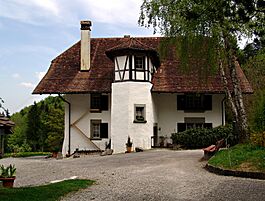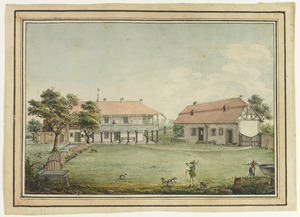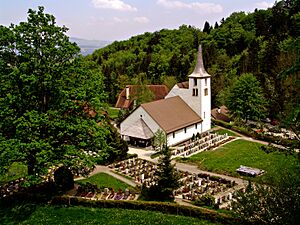Blumenstein facts for kids
Quick facts for kids
Blumenstein
|
||
|---|---|---|

A house in Blumenstein
|
||
|
||
| Country | Switzerland | |
| Canton | Bern | |
| District | Thun | |
| Area | ||
| • Total | 15.52 km2 (5.99 sq mi) | |
| Elevation | 659 m (2,162 ft) | |
| Population
(Dec 2020 )
|
||
| • Total | 1,236 | |
| • Density | 79.64/km2 (206.26/sq mi) | |
| Postal code |
3638
|
|
| Surrounded by | Därstetten, Forst, Längenbühl, Pohlern, Rüeggisberg, Rüti bei Riggisberg, Uebeschi, Wattenwil | |
Blumenstein is a cool town, also called a municipality, in Switzerland. It's located in the Bern area, near the city of Thun.
Contents
History of Blumenstein
Blumenstein was first written about in 1305. Back then, it was called Bluomenstein. Another nearby area, Tannenbühl, was mentioned in 1316. It later became known as Outer-Blumenstein in 1859.
In 1348, a part of Blumenstein was sold to the city of Bern. Later, a family bought it and called themselves von Blumenstein. They might have built a castle nearby. This castle later fell apart and was taken down in 1606.
Over the years, different parts of the village were sold many times. In 1642, Blumenstein was sold back to Bern. It then became part of the Thun District.
The village church, St. Niklaus, was probably built around the 11th century. It was first mentioned in records in 1285. A new church was built on the same spot in the 14th century.
Natural mineral springs were found in Blumenstein in the 1500s. Around 1900, these springs became a popular spot for a spa and health resort. Long ago, most people in Blumenstein worked as farmers or raised dairy cows. Even today, about half of the jobs in the town are still in farming. Many people also travel to nearby cities for work.
Some small villages, like Tannenbühl and Bodenzingen, were once separate. They were known as the court of Tannenbühl. In 1594, they became part of another area called Thierachern. In 1607, Bern bought Thierachern and added it to the Thun District.
These villages used to belong to a different church area. But in 1676, Tannenbühl was joined with the Blumenstein church. This led to the communities becoming closer. In 1859, they officially joined to form one town, Blumenstein.
Blumenstein's Geography
Blumenstein covers an area of about 15.52 square kilometers (6 square miles). A large part of the land, about 48.4%, is used for farming. Forests cover another big part, about 39.9% of the area.
About 3.9% of the town is covered by buildings and roads. A small part, 1.4%, is rivers or lakes. The remaining 6.5% is land that can't be used for farming or building, like rocky areas.
The town is located in a valley called Stockental and the upper Gürbetal. It includes the main village of Blumenstein and several smaller areas. These smaller areas include Wäsemli, Eschli, Gassen, Rüdeli, Lochmannsbühl, Reckenbühl, Bodenzingen, and Tannenbühl. Tannenbühl used to be its own town until 1859, when it became part of Blumenstein.
In 2010, Blumenstein joined a new administrative area called Verwaltungskreis Thun.
Blumenstein's Coat of Arms
The design of Blumenstein's coat of arms shows three golden lilies coming out of three silver rocks on a blue background. This design is a fun example of a "canting arm". It means the picture on the shield gives a hint about the name. "Blumen" means flowers (like lilies) and "Stein" means stone or rock in German.
People of Blumenstein (Demographics)
As of December 2012, Blumenstein had a population of 1,184 people. Only a small number, about 3.4%, were people from other countries. Between 2010 and 2012, the population grew slightly by 1.1%. Most of this growth was from people moving into the town.
Most people in Blumenstein (97.1%) speak German as their main language. Albanian is the second most common language, spoken by 1.8% of the people. A few people also speak French or Italian.
In 2008, about 51.2% of the population was male and 48.8% was female. Many people (38.2%) were born in Blumenstein and still lived there in 2000. Others were born in the same canton (43.1%) or elsewhere in Switzerland (7.8%). About 5.1% were born outside Switzerland.
In 2012, young people (0-19 years old) made up 19.3% of the population. Adults (20-64 years old) were 60.2%, and seniors (over 64) were 20.5%.
In 2000, there were 493 single people and 576 married people in Blumenstein. There were also 73 widows or widowers and 50 divorced people.
The number of people living in Blumenstein has changed over time:

Blumenstein's Economy
In 2011, Blumenstein had a low unemployment rate of 1.21%. A total of 413 people had jobs in the town. Many of these jobs were in farming (64 people).
Other jobs were in manufacturing and construction (170 people). About 180 people worked in services, like shops, restaurants, or healthcare. About 39.6% of the workers were women.
In 2000, 164 people traveled into Blumenstein for work. However, 396 people traveled out of Blumenstein to work elsewhere. This means more people leave the town for work than come in. About 57.6% of the workers in Blumenstein also lived there.
Many people (54.3%) used a private car to get to work. About 13.4% used public transportation.
The local tax rates in Blumenstein are among the lowest in the Bern area. For example, in 2012, a married person with two children earning 150,000 Swiss francs paid about 11.9% in local and canton taxes.
Important Heritage Sites
The Swiss Reformed Church in Blumenstein is a very important building. It is listed as a Swiss heritage site of national significance. Also, the entire small villages and churches of Blumenstein, Wäsemli, and Eschli are part of the Inventory of Swiss Heritage Sites. This means they are important places to protect for their history and culture.
Religion in Blumenstein
Based on the 2000 census, most people in Blumenstein (80.0%) belonged to the Swiss Reformed Church. About 5.0% were Roman Catholic.
A small number of people (3.86%) belonged to other Christian churches. About 3.10% were Muslim. Some people (2.43%) said they didn't belong to any church, or were agnostic or atheist.
Blumenstein's Climate
Between 1981 and 2010, Blumenstein had about 138.4 days of rain or snow each year. On average, it received about 1260 millimeters (49.6 inches) of precipitation.
The wettest month was July, with about 155 millimeters (6.1 inches) of rain or snow. It rained or snowed for about 12.9 days in July. May had the most days with precipitation (14 days), but with less rain or snow overall. The driest month was January, with about 68 millimeters (2.7 inches) of precipitation over 10.6 days.
Education in Blumenstein
In Blumenstein, about 54.1% of people have finished non-mandatory upper secondary education. Also, 13.4% have completed higher education, like attending a university or a specialized college.
The school system in the Canton of Bern starts with one year of optional Kindergarten. After that, students go to six years of Primary school. Then, they have three years of mandatory lower Secondary school. In secondary school, students are grouped based on their abilities. After lower secondary, students can continue their education or start an apprenticeship (learning a trade on the job).
During the 2012-2013 school year, 119 students attended classes in Blumenstein. There were 42 students in kindergarten. The primary school had 63 students. The lower secondary school had 14 students. Some students (about 7.1% in secondary school) were from other countries or had a different first language.
In 2000, 204 students attended school in Blumenstein. Most of them (133) lived and went to school in the town. However, 71 students came from other towns to study in Blumenstein. Also, 53 students from Blumenstein went to schools outside the town.
Notable People from Blumenstein
- Sandra Dombrowski, an ice hockey player and referee.
- Christian Winkler, a baker.
See also
 In Spanish: Blumenstein para niños
In Spanish: Blumenstein para niños








